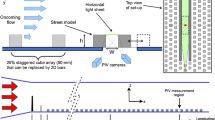Abstract
In order to investigate the microclimatic conditions in a street canyon, a physical model was used to conduct the Joint ATREUS-PICADA Experiment (JAPEX) in situ experimental campaign. Four lines of buildings simulated by steel containers were installed to form three parallel street canyons at 1:5 scale, with width/height aspect ratio approximately 0.40. The reference wind and atmospheric conditions were measured, as well as the flow velocity and direction in the street. Preliminary results concern street canyon ventilation and thermal effects on in-canyon airflow, and show that vortical motions appear for reference wind directions perpendicular to the street axis. The presence of adjacent rows of buildings did not appear to significantly influence the flow character within the canyon for the case of a low aspect ratio corresponding to a skimming flow regime. The flow structure was not significantly affected by the thermal effects although some slight interference occurred in the lower part of the canyon. An analysis of horizontal temperature gradients indicated that a thin boundary layer develops near the heated facade. These facts imply that the thermal effects are considerable only very close to the wall.
Similar content being viewed by others
References
Bohnenstengel S, Schlünzen KH, Grawe D (2004) Influence of thermal effects on street canyon circulations. Meteorologische Zeitschrift 13(5):381–386
Bourbia F, Awbi HB (2004) Building cluster and shading in urban canyon for hot dry climate, Part 1: air and surface temperature measurements. Renewable Energy 29: 249–262
Brown MJ, Boswell D, Streit G, Nelson M, McPherson T, Hilton T, Pardyjak ER, Pol S, Ramamurthy P, Hansen B, Kastner–Klein P, Clark J, Moore A, Walker D, Felton N, Strickland D, Brook D, Princevac M, Zajic D, Wayson R, MacDonald J, Fleming G, Storwold D (2004) Joint urban 2003 street canyon experiment. 2004 AMS Annual Meeting Symposium on Planning, Nowcasting, and Forecasting in the Urban Zone J7.3, Seattle WA, January 2004
Demilecamps L, André H (2005) Le projet PICADA (Photocatalytic Innovative Coverings Applications for Depollution Assessment). Travaux 821:69–73
DePaul FT, Sheih CM (1986) Measurements of wind velocities in a street canyon. Atmos Environ 20:455–459
Eliasson I, Offerle B, Grimmond CSB, Lindqvist S (2006) Wind and turbulence statistics in an urban street canyon. Atmos Environ 40:1–16
Hussain M, Lee BE (1980) An investigation of wind forces on three-dimensional roughness elements in a simulated atmospheric boundary layer flow—Part II. Flow over large arrays of identical roughness elements and the effect of frontal and side aspect ratio variations. Report No. BS 56, Department of Building Sciences, University of Sheffield, UK
Kim J-J, Baik J-J (1999) A numerical study of thermal effects on flow and pollutant dispersion in urban street canyons. J Appl Meteorol 38:1249–1261
Kim J-J, Baik J-J.(2001) Urban street-canyon flows with bottom heating. Atmos Environ 35:3395–3404
Kovar-Panskus A, Moulinneuf L, Savory E, Abdelqari A, Sini JF, Rosant JM, Robins A, Savory E, Toy N (2002) A wind tunnel investigation of the influence of solar-induced wall-heating on the flow regime within a simulated urban street canyon. Water Air Soil Pollut: Focus 2(5–6): 555–571
Louka P, Vachon G, Sini J-F, Mestayer PG, Rosant J-M (2002) Thermal effects on the airflow in a street canyon–Nantes’99 experimental results and model simulations. Water Air and Soil Pollut: Focus 2(5–6):351–364
Nakamura Y, Oke TR (1988) Wind, temperature and stability conditions in an east–west oriented urban canyon. Atmos Environ 22:2691–2700
Oke TR (1987) Boundary layer climates, Methuen and Co. Ltd., London, 2nd edn, 435 pp
Oke TR (1988) Street design and urban canopy layer climate. Energy Buildings 11:103–113
Papadopoulos A (2005) ATREUS Executive Scientific Report. Contract No: HPRN-CT-2002–00207 final report, Laboratory of Heat Transfer and Environmental Engineering (LHTEE), Dept. of Mechanical Engineering, Aristotle University Thessaloniki (AUT), GR-54124 Thessaloniki, e-mail: agis@eng.auth.gr
Papadopoulos AM, Moussiopoulos N (2004) Towards an holistic approach for the urban environment and its impact on energy utilization in buildings: The ATREUS project. J Environ Monit 6:841–848
Rowley FB, Algren AB, Blackshaw JL (1930) Surface conductances as affected by air velocity, temperature and character of surface. ASHRAE Trans 38:33–46
Santamouris M, Papanikolaou N, Koronakis I, Livada I, Assimakopoulos D (1999) Thermal and airflow characteristics in a deep pedestrian canyon under hot weather conditions. Atmos Environ 33:4503–4521
Sini JF, Anquetin S, Mestayer PG (1996) Pollutant dispersion and thermal effects in urban street canyons. Atmos Environ 30:2659–2677
Vachon G, Rosant J-M, Mestayer PG, Sini JF (1999) Measurements of dynamic and thermal field in a street canyon. URBCAP Nantes’99. 6th International Conference on Harmonisation within Atmospheric Dispersion Modelling for Regulatory Purposes, Rouen, France, October 1999
Xie X, Huang Z, Wang J, Xie Z (2005) The impact of solar radiation and street layout on pollutant dispersion in street canyon. Build Environ 40:201–212
Zajic D, Fernando HJS, Brown MJ, Kim J-J, Baik J-J (2003) Flow and turbulence in simulated city canyons; Measurements and computations. Proc. of Fifth International Conference on Urban Climate, Lodz, Poland, September 1–5, 1, pp 479–482
Author information
Authors and Affiliations
Corresponding author
Rights and permissions
About this article
Cite this article
Idczak, M., Mestayer, P., Rosant, JM. et al. Micrometeorological Measurements in a Street Canyon during the Joint ATREUS-PICADA Experiment. Boundary-Layer Meteorol 124, 25–41 (2007). https://doi.org/10.1007/s10546-006-9095-z
Received:
Accepted:
Published:
Issue Date:
DOI: https://doi.org/10.1007/s10546-006-9095-z




